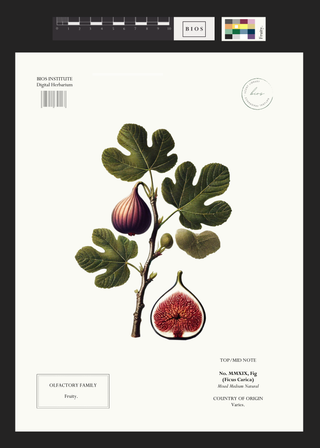

Ficus carica, commonly known as the common fig, is native to the region encompassing Western Asia and the eastern Mediterranean. It is believed to have originated in the area that includes modern-day Turkey, Greece, and parts of Syria and Iran. We source ours from various countries as the cultivation of Ficus carica has spread to different parts of the world with suitable climates, and fig trees are now grown in many regions globally.
The fragrance of fig is reminiscent of the ripe fruit itself, with its lush and juicy aroma. It can evoke a sense of Mediterranean landscapes, sun-soaked gardens, and the allure of exotic destinations. Fig fragrances are often described as green, woody, creamy, and slightly earthy.
Fig is a popular note in perfumery, known for its unique and distinctive scent. The scent of fig in perfumes can range from green and fresh to sweet and fruity, depending on the specific fragrance composition. Fig is a Top/Middle note in our Fruity family.
In perfumery, fig is versatile and can be combined with various other notes to create different olfactory experiences. It can be blended with citrus fruits, floral notes like jasmine or violet, woody notes such as cedar or sandalwood, and even spices like cinnamon or clove. This versatility allows perfumers to create fragrances that range from fresh and airy to warm and sensual. Fig is often used as a middle or base note in perfumes, providing depth, warmth, and a touch of sweetness.
The use of fig in perfumery is not limited to the fruit itself. Other parts of the fig tree, such as the leaves and the milky sap known as "fig milk," are also utilized to capture different aspects of the fig scent profile. This adds complexity and depth to fig-based perfumes.
The fig tree has symbolic and cultural significance in various cultures as well. It is associated with fertility, abundance, and the Mediterranean region. The fig fruit holds symbolic meanings of nourishment, wisdom, and sensuality. In some cultures, the fig tree is considered sacred or has mythological associations.
Overall, fig is a versatile and captivating ingredient in perfumery, offering a range of olfactory experiences and adding a touch of allure and exoticism to fragrances.
The fig tree has a long history in Mediterranean and Middle Eastern cultures. In ancient times, it was regarded as a sacred tree and associated with fertility, abundance, and protection. The fig fruit holds symbolic meanings of wisdom, sensuality, and spiritual enlightenment. In some cultures, figs are offered during religious ceremonies and are considered a blessed fruit. In Greek mythology, the fig tree was associated with Dionysus, the god of wine and celebration.
In ancient Egypt, the fig tree was considered a sacred tree associated with fertility and regeneration. The fig was seen as a symbol of life and prosperity. Fig trees were commonly found in temple gardens and were associated with the goddess Hathor, who was the goddess of fertility, music, and love.
In Hinduism, the fig tree holds significance and is associated with Lord Vishnu and Lord Krishna. The Banyan tree, which is a type of fig tree, is considered sacred and symbolizes eternal life. It is often found near temples and is considered a holy tree.
In Chinese culture, the fig tree is associated with longevity and good luck. It is believed that having a fig tree in or around the house brings prosperity and positive energy. The fig fruit is also associated with abundance and is sometimes used in traditional Chinese medicine for its health benefits.
Fig
- Unit price
- /per
Please note this product format is a small vial that contains roughly 20 drops of scent concentrate. This can be purchased à la carte but is intended to be used with our Perfume Kit.
SCENT SPECIFICATIONS
Latin Name: Ficus Carica
Extraction Method: Isolate
Country of Origin: Varies
All of the scents in our library our naturally derived - our collection includes essential oils, absolutes, concretes, isolates, enfleurage, macerations, oleoresins, and mixed medium naturals.
Adding product to your cart
Ficus carica, commonly known as the common fig, is native to the region encompassing Western Asia and the eastern Mediterranean. It is believed to have originated in the area that includes modern-day Turkey, Greece, and parts of Syria and Iran. We source ours from various countries as the cultivation of Ficus carica has spread to different parts of the world with suitable climates, and fig trees are now grown in many regions globally.
The fragrance of fig is reminiscent of the ripe fruit itself, with its lush and juicy aroma. It can evoke a sense of Mediterranean landscapes, sun-soaked gardens, and the allure of exotic destinations. Fig fragrances are often described as green, woody, creamy, and slightly earthy.
Fig is a popular note in perfumery, known for its unique and distinctive scent. The scent of fig in perfumes can range from green and fresh to sweet and fruity, depending on the specific fragrance composition. Fig is a Top/Middle note in our Fruity family.
In perfumery, fig is versatile and can be combined with various other notes to create different olfactory experiences. It can be blended with citrus fruits, floral notes like jasmine or violet, woody notes such as cedar or sandalwood, and even spices like cinnamon or clove. This versatility allows perfumers to create fragrances that range from fresh and airy to warm and sensual. Fig is often used as a middle or base note in perfumes, providing depth, warmth, and a touch of sweetness.
The use of fig in perfumery is not limited to the fruit itself. Other parts of the fig tree, such as the leaves and the milky sap known as "fig milk," are also utilized to capture different aspects of the fig scent profile. This adds complexity and depth to fig-based perfumes.
The fig tree has symbolic and cultural significance in various cultures as well. It is associated with fertility, abundance, and the Mediterranean region. The fig fruit holds symbolic meanings of nourishment, wisdom, and sensuality. In some cultures, the fig tree is considered sacred or has mythological associations.
Overall, fig is a versatile and captivating ingredient in perfumery, offering a range of olfactory experiences and adding a touch of allure and exoticism to fragrances.
The fig tree has a long history in Mediterranean and Middle Eastern cultures. In ancient times, it was regarded as a sacred tree and associated with fertility, abundance, and protection. The fig fruit holds symbolic meanings of wisdom, sensuality, and spiritual enlightenment. In some cultures, figs are offered during religious ceremonies and are considered a blessed fruit. In Greek mythology, the fig tree was associated with Dionysus, the god of wine and celebration.
In ancient Egypt, the fig tree was considered a sacred tree associated with fertility and regeneration. The fig was seen as a symbol of life and prosperity. Fig trees were commonly found in temple gardens and were associated with the goddess Hathor, who was the goddess of fertility, music, and love.
In Hinduism, the fig tree holds significance and is associated with Lord Vishnu and Lord Krishna. The Banyan tree, which is a type of fig tree, is considered sacred and symbolizes eternal life. It is often found near temples and is considered a holy tree.
In Chinese culture, the fig tree is associated with longevity and good luck. It is believed that having a fig tree in or around the house brings prosperity and positive energy. The fig fruit is also associated with abundance and is sometimes used in traditional Chinese medicine for its health benefits.
